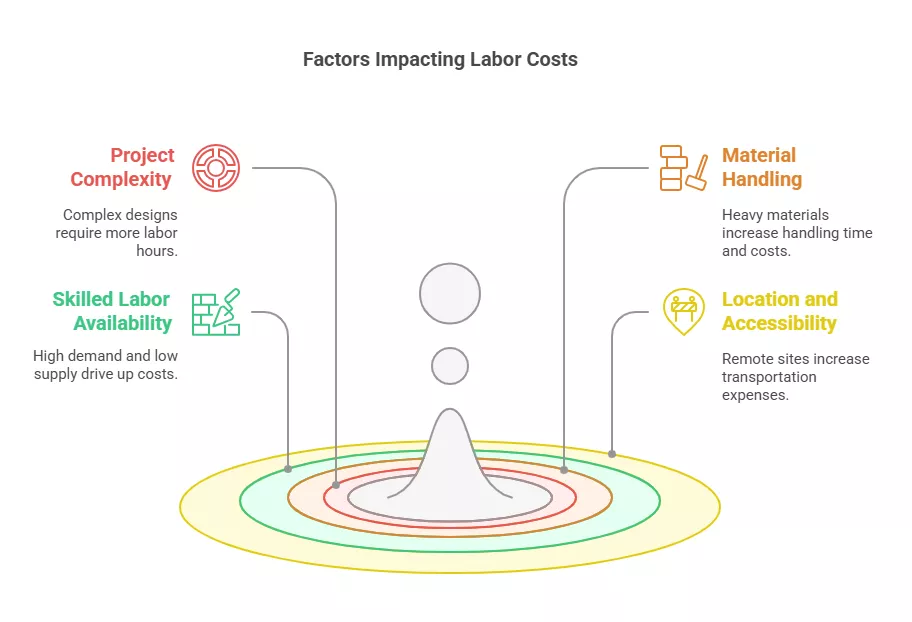Ranked #1 in Accurate and Reliable Estimation Services
A Fastest Turnaround 24 Hours!
Ranked #1 in Accurate and Reliable Estimation Services
A Fastest Turnaround 24 Hours!
Ranked #1 in Accurate and Reliable Estimation Services
A Fastest Turnaround 24 Hours!
Ranked #1 in Accurate and Reliable Estimation Services
A Fastest Turnaround 24 Hours!

Whether you are constructing a building, a patio, or a feature wall, there is so much to think about: planning, budgeting, designing, and so on. However, one factor that stands out the most is labor costs. Depending on the type of masonry you choose, either brick or stone, it can have a huge impact on your project’s expenditure. One troubling aspect is that not too many contractors consider labor as a significant factor in their budget. Does that mean stone masonry is always costlier? Or does the difficulty of the project matter more?
In the narrative ahead, I will share all details pertaining to labor expenditure for both stone masonry as well as brick masonry so you understand exactly how much time, skills, and resources are needed for each. You will not be left in the dark with uncertainty for your next project either; by the conclusion of this article, you will be equipped with knowledge on whether you should go with stone or brick.
One of the common construction methods is Brick masonry which includes arranging baked clay or concrete bricks into walls, facades, and other structures. It is widely adopted because of its construction speed, ease of use, strength, and multifunctionality. Bricks are easy to manage as they are molded into specific standard shapes and sizes.
Stone masonry involves using natural stones, like granite, limestone, or sandstone, to build structures. These stones are usually larger and heavier than bricks, and each one is unique, requiring a more customized approach. Stone masonry is often chosen for its beauty and timeless appeal.
Brick masonry is generally faster because bricks are easier to handle and lay. A skilled mason can typically lay 300 to 500 bricks per day, depending on the complexity of the project. This allows for quicker project completion, making it more cost-effective in terms of labor.
Compared to wood and brick work, stone masonry is much time and skill consuming. They carry more weight, which makes moving and cutting them more labor-intensive. A stone mason has to shape each stone to the structure which adds a considerable costs of time and labor. According to estimates, a stone mason can lay roughly thirty to fifty square feet of stone in a day depending on type of stone and how complex the project is.
Key Difference: Stone masonry requires 2 to 3 times more labor than brick masonry because of the extra time and skill needed for handling and fitting stones.
The more complex the design, the more labor is required. For example, a decorative stone wall with varying sizes and shapes of stones will take longer than a simple brick wall.
Stone is much heavier and more cumbersome to handle than brick. This means more labor hours are spent on moving and cutting the stone. Additionally, stone masonry often requires more precise cutting and fitting, which adds to labor costs.
There’s a higher demand for skilled stone masons than brick masons. Since fewer people are trained in stone masonry, the labor costs for stone projects can be higher. In certain areas, finding qualified stone masons may be difficult, further driving up costs.
The location of the project can also influence labor costs. If the site is difficult to access or located in a remote area, transporting both materials and labor will increase costs. Stone, being heavier, can make this even more expensive.

For brick masonry, you can expect labor costs to range from $40 to $70 per hour for a skilled mason. Depending on the project’s size, the labor cost per square foot is generally between $10 and $15.
On the other hand, stone masonry work is priced at an hourly rate of between $60 and $100. In terms of square footage, the labor costs for stone work begin at $20 and can go up to $40 or more depending on the project’s intricacy and the type of stone used.
This shows that stone masonry tends to be 2 to 3 times more expensive in labor than brick masonry.
Well-structured strategies can elicit optimal outcomes on both saving time and resources. Proper stratification of tasks and having all necessary instructions put in one place will ensure all site materials are ordered before any schedule activities are executed. Avoidance of needless expenses and delays can streamlined through eliminating “uhm” pauses related to a lack of related multi-phase plans.
Stones may be appealing from an aesthetic point of view but require investment of time to work with; for those short on time, simpler or synthetic stones are a quicker option. The same can be said about bricks; tailor-cut bricks do take longer to produce than standardized ones, which slows down the entire process.
Engaging the services of professionally trained masons who specialize in stone or brick will guarantee effective completion of the project. Even though they may have higher upfront costs, they complete the work in less time and with greater accuracy, thus minimizing overall expenditure on labor.
For stone masonry, tools like stone cutting saws or even masonry machines can help speed up the work, reducing the amount of labor required.
Let’s look at a practical example for a garden wall project:
This example shows how stone masonry can increase labor costs due to the extra time and skill required.
In the event you plan to choose between brick and stone masonry, the essential factor is the time and effort you are willing to spend. For most, brick masonry proves easier on the wallet, especially for less complex projects. Stone masonry is more expensive but is of greater value to most homeowners and contractors due to its beauty and durability especially in high-end, decorative projects.
Ultimately, gaining an understanding of labor costs for the specific type of masonry will assist you in making the most rational decision in regards to your project finances. Both contractors and homeowners alike can utilize this information to manage their project funds while achieving the results desired.
If you need help with accurately estimating labor costs for your masonry project, consider using a masonry estimation service to ensure your budget aligns with real-time project needs.
0 Comments